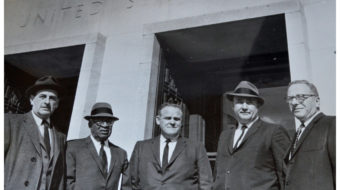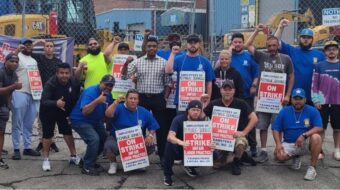
ART REVIEW
LOS ANGELES — “At Work” is an artistic chronicle of labor in California, not a dead past, but a living history that continues to evolve and grow. To make its point, the exhibit presents a balance of paintings, prints and drawings alongside a number of photographic works, with contemporary artworks shown alongside creations from times past.
A good portion of the exhibit is by Latino artists and focuses on Mexican American workers, who have undeniably played a major role in the saga of California labor. Their contributions as told through the eyes of artists are well represented in the exhibition, from the varied silkscreen prints celebrating the United Farm Workers to the latest installation piece by Ricardo Duffy commemorating L.A.’s million-person march in support of immigrant workers’ rights.
At the opening I had an opportunity to talk with one of the show’s exhibiting photographers, Gil Ortiz. He told me about the photograph he had taken in 1974 of an agricultural worker bent over in backbreaking labor, digging in California’s fields with a short-handled hoe, a tool that caused arthritis of the spine and ruptured spinal disks for those who used it. The New York Times picked up and published Ortiz’s photo for an article about California’s United Farm Workers union. Of his photo, Ortiz said: “In one picture, I sought to capture the inhumanity of ‘el cortito,’ the crippling short-handled hoe that had come to symbolize stoop labor and the cruel exploitation that the farm workers were fighting. My work follows one history in the tradition of documentary photography, that of allowing images to capture the inhumane treatment of human beings, particularly the exploitation of labor for profit.”
The Pulitzer Prize-winning cartoonist for the Los Angeles Times, Paul Conrad, saw Ortiz’s photo and based a cartoon upon the arresting image, giving the photographer full credit for inspiring the drawing. Conrad’s cartoon depicted a farm worker as the victim of a violent crime, showing the laborer lying face down amid cultivated rows of crops — a hoe brutally stuck into his bloodied back like a spear. Ortiz’s photo and Conrad’s cartoon brought attention to the misery of agricultural workers, and finally in the mid-1970s the California Supreme Court banned the use of the tool.
I’m continually asked if art makes a difference, if it’s a force capable of changing society, and if it has any power at all outside of itself. I can think of no better example of art’s transformative energy than Gil Ortiz’s photograph — and this exhibit is filled with such images.
“At Work” is not just a consideration of Latino workers and the art created about them. It is, after all, dedicated to the entire working class in all of its diversity. Some of the strongest artworks in the exhibit were created by those American artists belonging to the social realist school of the 1930s, when art and social concerns were inextricably linked. There is much to be learned from the social realist artists of the 1930s, and if just a tiny amount of their idealism, commitment and vision were to rub off on us, we’d all be better off.
Of particular interest to me are the two photographs on display by Dorothea Lange, a personal hero of mine. Her photos are of factory workers leaving their shift, exiting their workplaces en masse, tired looking but also proud, possessing an inner strength that makes them appear implacable. Gazing at the workers in Lange’s photos, looking smart in their work clothes and wearing optimistic faces or grim expressions, I was overwhelmed with empathy, but also struck at how different U.S. workers seem today.
“Solidarity,” my own painting on display in the exhibit, in part addresses that dissimilarity — but globalization, technology and other changes in the work environment not only continue to place great pressures upon labor, they challenge artists to comprehend and help make clear the evolving situation.
For more information on “At Work,” including a full listing of participating artists, a schedule of public events, and maps to the Pico House, please visit www.art-for-a-change.com/exhibits/atwork.htm.
“At Work: The Art of California Labor,” was originated by the California Historical Society and the San Francisco State University and curated by Mark Dean Johnson, director, Fine Arts Gallery, San Francisco State University.
The L.A. show was expanded to an additional 30 artists and 40 pieces of art as well as nine archival posters. The exhibit was made possible through the generous support of El Pueblo Park Association and is co-sponsored by the Center for the Study of Political Graphics, The Historic Italian Hall Foundation and the Echo Park Film Center.
The exhibition tour is coordinated by the California Exhibition Resources Alliance and is funded through the James Irvine Foundation.
At Work: The Art of California Labor
Through Aug. 14
Curated by Mariann Gatto
and Shervin Shahbazi
The Pico House Gallery,
Olvera St., Los Angeles
Open daily, 10 a.m. – 3 p.m.









